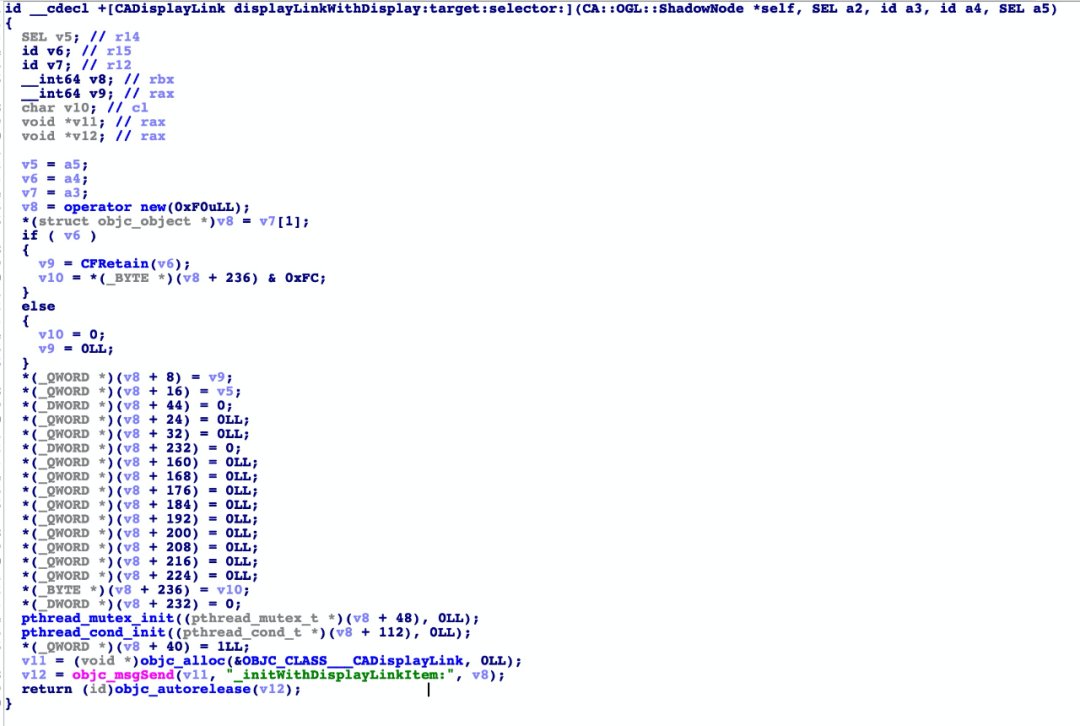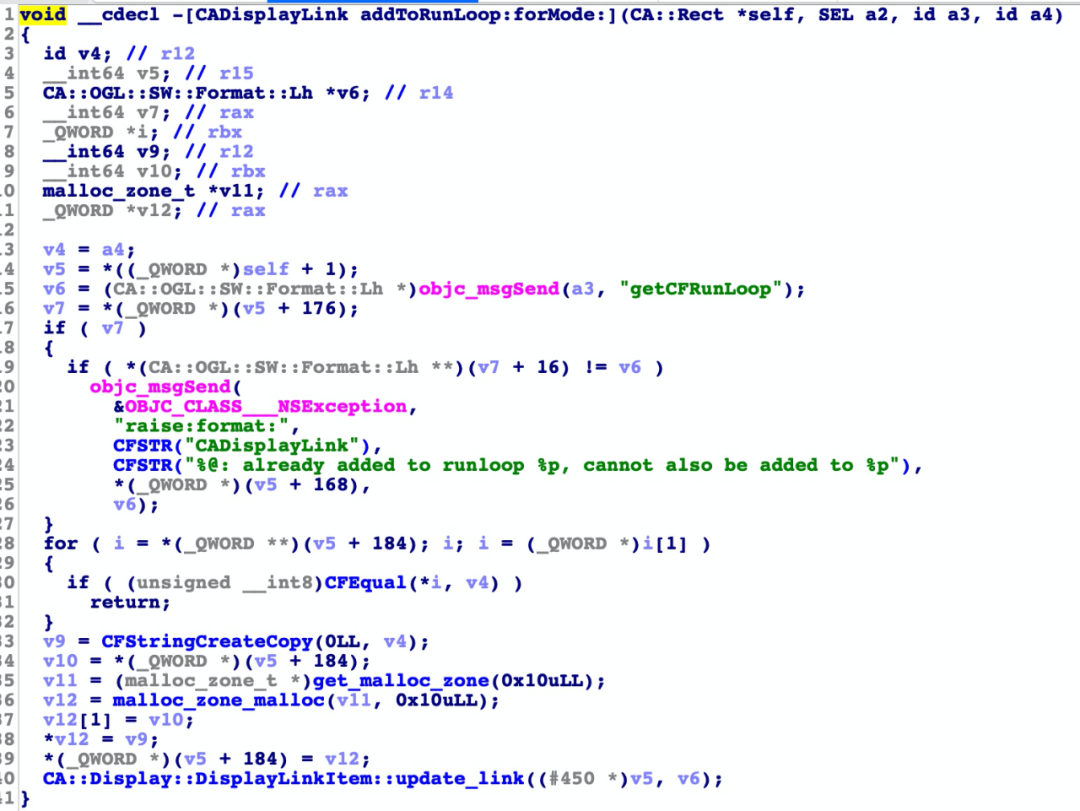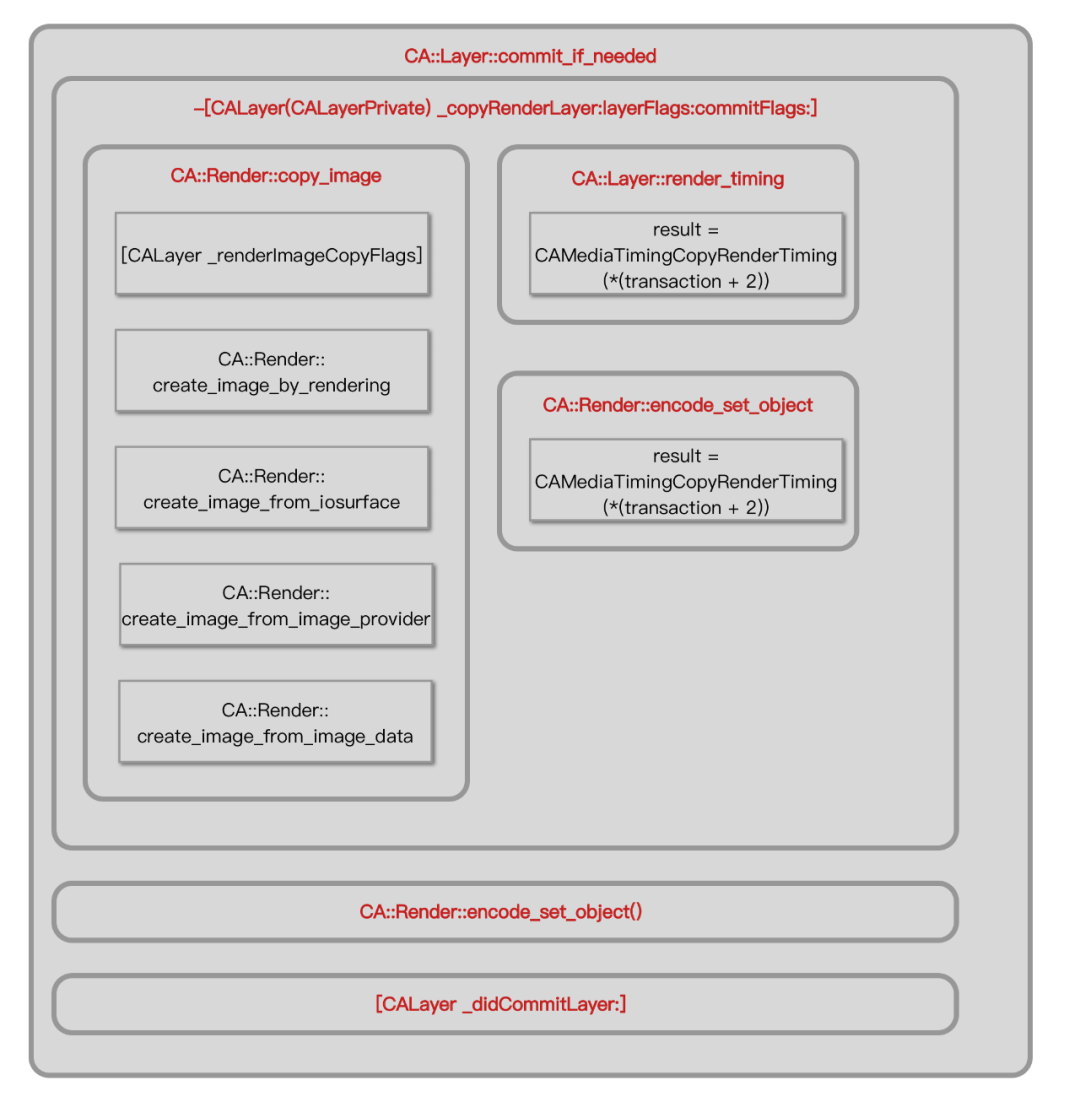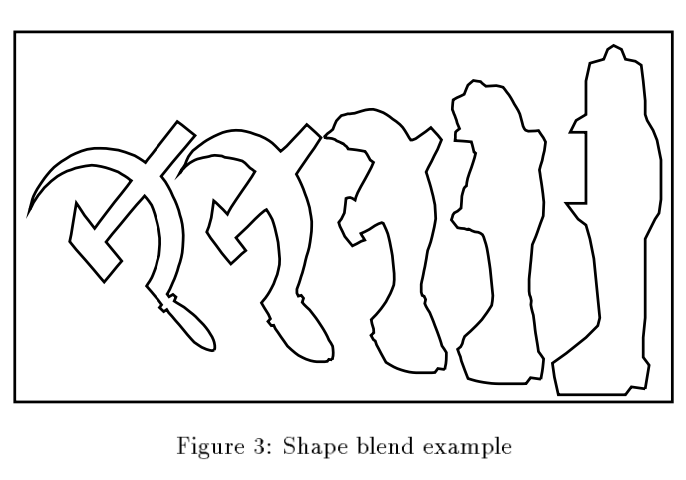谈 UIKit 和 CoreAnimation 在 iOS 渲染中的角色(下)
小试牛刀之 CADisplayLink
POP 库基于 CADisplayLink 注册 VSync 信号,如何注册的呢?VSync 信号到底是个啥呢?首先,我们打印一下 CADisplayLink 的触发堆栈:
CADisplayLink 的 Runloop 多了一个 source1:
2 : <CFRunLoopSource 0x282dc8000 [0x1cadcf728]>{
signalled = No, valid = Yes, order = -1,
context = <CFMachPort 0x282fd8160 [0x1cadcf728]>{
valid = Yes, port = 440b, source = 0x282dc8000,
callout = _ZL22display_timer_callbackP12__CFMachPortPvlS1_ (0x187592b2c),
context = <CFMachPort context 0x2823d0000>
}
}有这样一个 source1 被加入了 Runloop。CADisplaylink 也是基于这个 port完成了 VSync 信号的注册工作。产生 VSync 信号的进程,每 16.7ms 进行一次到这个 port 的 mach msg 发送工作,从而不断的激活本 App 的 Runloop ,触发一个 item,完成本 App 对 VSync 的感知。这里说点题外的,看到item,很自然的联想到这里是不是一个链表之类的数据结构。实际上,我们可以多次添加不同的 CADisplayLink instance 到 Runloop 中,就像这样:
CADispalyLink *link = [CADisplayLink displayLinkWithTarget:self selector:@selector(drawSomething)];
[link addToRunLoop:[NSRunLoop currentRunLoop] forMode:NSRunLoopCommonModes];
CADispalyLink *link2 = [CADisplayLink displayLinkWithTarget:self selector:@selector(drawSomething2)];
[link2 addToRunLoop:[NSRunLoop currentRunLoop] forMode:NSRunLoopCommonModes];但是如果这样写:
CADispalyLink *link = [CADisplayLink displayLinkWithTarget:self selector:@selector(drawSomething)];
[link addToRunLoop:[NSRunLoop currentRunLoop] forMode:NSRunLoopCommonModes];
CADispalyLink *link2 = [CADisplayLink displayLinkWithTarget:self selector:@selector(drawSomething)];
[link2 addToRunLoop:[NSRunLoop currentRunLoop] forMode:NSRunLoopCommonModes];绿色高亮部分的差异会造成什么呢?drawSomeThing 在一个 VSync message 里被触发了两次。原因是:[CADisplayLink displayLinkWithTarget:self selector:@selector(drawSomeThing)] 这个方法内部的 [CADisplayLink displayLinkWithDisplay:target:selector:] 调用新生成了一个 DisplayLinkItem (下图汇编代码中的 v8)。
调用 [CADisplayLink addToRunLoop:forMode:]时,内部:
这里的逻辑只检测了:
- 如果这个 displayLink 已经被加入到其他 Runloop 中,直接抛出 exception;
- 如果重复添加某个 mode,则直接 return(Runloop 仍然为 link 的 Runloop)所以新的 item 会被顺利加入,然后每次 VSync 触发两次。
下面我们总结一下基于CoreAnimation的Animation和基于POP的Animation的区别,可以用以下流程图解答: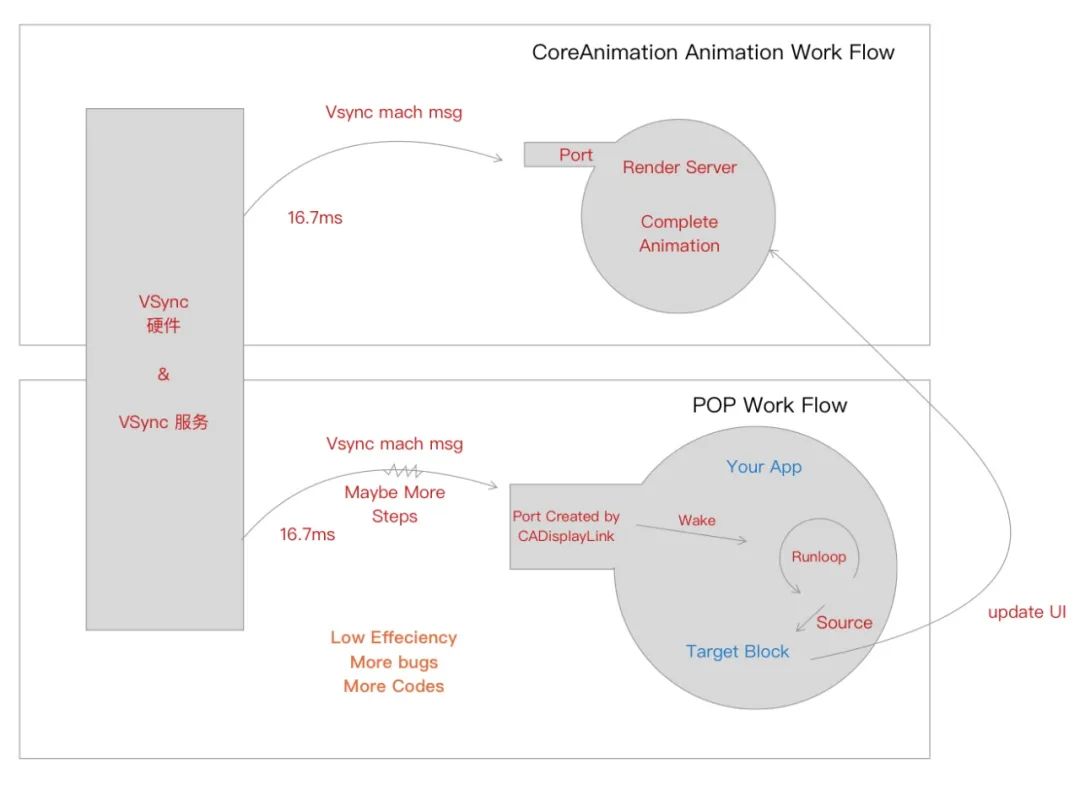
- CADisplayLink 创建了 port,使 App 能够感知 Vsync信号(不管经过多少了中间步骤)
- 感知 VSync 信号使我们能够 16.7ms 更新一次 UI
- 16.7ms 更新 UI 即可完成动画效果
但是显而易见,有以下不足:
- 基于多次系统IPC的VSync信号感知,性能必然大打折扣。
- 撰写更多的 code 去控制UI,处理边界情况。
- 没有经过亿级设备检验过的 Animation Code 99%的可能有相对更多的bug。
总结可得到以下两个问题的答案:
如何进入 waiting?
调用 mach_msg,设置好 timeout 参数和 wait_port 就可以进入内核态等待 mach_msg 的来临
如何 wakeup?
- 注册 source1 事件,被外部进程的通过 IPC 激活
- 通过 timer 激活
- 通过其他线程手动 wakeup 该线程的某个 source0。
- 通过 gcd 的 Dispatch port(本质上也是 source1 事件,但是跟其他线程 IPC 稍有区别,属于自己跟自己 IPC)
说了这么一圈,我们了解了Runloop本质是在处理mach msg。那么我们什么时候做渲染呢?viewdidload、layoutSubviews 等等中代码,到底是在 Runloop 哪里被触发的呢?
Runloop 如何触发渲染?
由于 Runloop 比较多的 mode ,每个 mode 都是在组合常见的几个 item ,关于 mode 和 item 不清楚的同学可以自行查阅相关资料,这里打印出一个 Runloop 的 debugDescription 来说明:
<CFRunLoop 0x6000001d8100 [0x1c04a6510]>{wakeup port = 0x2303, stopped = false, ignoreWakeUps = false, current mode = kCFRunLoopDefaultMode,//首先,目前Runloop中存在两个mode,一个是UITracking,也就是滑动用的,一个是defaultcommon modes = <CFBasicHash 0x600003390ed0 [0x1c04a6510]>{type = mutable set, count = 2,entries => 0 : <CFString 0x1c0b2e5f0 [0x1c04a6510]>{contents = "UITrackingRunLoopMode"} 2 : <CFString 0x1c067c148 [0x1c04a6510]>{contents = "kCFRunLoopDefaultMode"}}
第一个mode——UITrackingRunLoopMode:
0 : <CFRunLoopMode 0x6000006d4410 [0x1c04a6510]>{ name = UITrackingRunLoopMode, port set = 0x4803, queue = 0x6000013d4e00, source = 0x6000013d4f00 (not fired), timer port = 0x4703, sources0 : { 0 : <CFRunLoopSource >{signalled = No, valid = Yes, order = -1, context = <CFRunLoopSource context>{version = 0, info = 0x0, callout = PurpleEventSignalCallback (0x18aebe530)}} 1 : <CFRunLoopSource >{signalled = No, valid = Yes, order = 0, context = <CFRunLoopSource context>{version = 0, info = 0x6000019c4a20, callout = FBSSerialQueueRunLoopSourceHandler (0x185729edc)}} 2 : <CFRunLoopSource >{signalled = No, valid = Yes, order = -1, context = <CFRunLoopSource context>{version = 0, info = 0x6000006c0000, callout = __eventQueueSourceCallback (0x1844477dc)}} 5 : <CFRunLoopSource >{signalled = No, valid = Yes, order = -2, context = <CFRunLoopSource context>{version = 0, info = 0x600003381140, callout = __eventFetcherSourceCallback (0x184447850)}} }, sources1 : { 0 : <CFRunLoopSource >{signalled = No, valid = Yes, order = -1, context = <CFRunLoopSource context>{version = 1, info = 0x3603, callout = PurpleEventCallback (0x18aebe538)}} }, observers = ( "<CFRunLoopObserver repeats = Yes, order = -2147483647, callout = _runLoopObserverCallout (0x183ee5508), context = (<_UIWeakReference: 0x600003fd4250>)}", "<CFRunLoopObserver repeats = Yes, order = 0, callout = _UIGestureRecognizerUpdateObserver (0x183f32638), context = <CFRunLoopObserver context 0x6000016c0000>}", "<CFRunLoopObserver repeats = Yes, order = 1999000, callout = _beforeCACommitHandler (0x1843dbf00), context = <CFRunLoopObserver context 0x125705a10>}", "<CFRunLoopObserver repeats = Yes, order = 2000000, callout = _ZN2CA11Transaction17observer_callbackEP19__CFRunLoopObservermPv (0x187561d54), context = <CFRunLoopObserver context 0x0>}", "<CFRunLoopObserver repeats = Yes, order = 2001000, callout = _afterCACommitHandler (0x1843dbf74), context = <CFRunLoopObserver context 0x125705a10>}", "<CFRunLoopObserver repeats = Yes, order = 2147483647, callout = _runLoopObserverCallout (0x183ee5508), context = (\n \"<_UIWeakReference: 0x600003fd4250>\"\n)}" ), timers = (null),},
比较有价值的,就是这个 _ZN2CA11Transaction17observer_callbackEP19__CFRunLoopObservermPv 函数了他是由 CoreAnimation 注册到 Runloop 的一个 observer 的回调。在这个 mode 下只有一个 source1,说明现在(仅代表测试程序环境)只能被来一个端口 msg 中断,也就是 PurpleEventCallback对应的端口。
第二个 mode -GSEventReceiveRunLoopMode:没有暴露的 mode,也是跟事件下发相关,不做探究
1 : <CFRunLoopMode 0x6000006d44e0 [0x1c04a6510]>{ name = GSEventReceiveRunLoopMode, port set = 0x4603, queue = 0x6000013d4f80, source = 0x6000013d5080 (not fired), timer port = 0x4403, sources0 = <CFBasicHash 0x600003385380 [0x1c04a6510]>{type = mutable set, count = 1, entries => 0 : <CFRunLoopSource 0x6000008d40c0 [0x1c04a6510]>{signalled = No, valid = Yes, order = -1, context = <CFRunLoopSource context>{version = 0, info = 0x0, callout = PurpleEventSignalCallback (0x18aebe530)}} }, sources1 = <CFBasicHash 0x6000033853b0 [0x1c04a6510]>{type = mutable set, count = 1, entries => 0 : <CFRunLoopSource 0x6000008d4480 [0x1c04a6510]>{signalled = No, valid = Yes, order = -1, context = <CFRunLoopSource context>{version = 1, info = 0x3603, callout = PurpleEventCallback (0x18aebe538)}} }, observers = (null), timers = (null), currently 628607093 (779024795576) / soft deadline in: 7.68614304e+11 sec (@ -1) / hard deadline in: 7.68614304e+11 sec (@ -1)},
第三个 mode - kCFRunLoopDefaultMode。
2 : <CFRunLoopMode 0x6000006dc000 [0x1c04a6510]>{ name = kCFRunLoopDefaultMode, port set = 0x5403, queue = 0x6000013dc700, source = 0x6000013dc800 (not fired), timer port = 0x2c03, sources0 = <CFBasicHash 0x600003385290 [0x1c04a6510]>{type = mutable set, count = 4, entries => 0 : <CFRunLoopSource 0x6000008d40c0 [0x1c04a6510]>{signalled = No, valid = Yes, order = -1, context = <CFRunLoopSource context>{version = 0, info = 0x0, callout = PurpleEventSignalCallback (0x18aebe530)}} 1 : <CFRunLoopSource 0x6000008dc000 [0x1c04a6510]>{signalled = No, valid = Yes, order = 0, context = <CFRunLoopSource context>{version = 0, info = 0x6000019c4a20, callout = FBSSerialQueueRunLoopSourceHandler (0x185729edc)}} 2 : <CFRunLoopSource 0x6000008d8180 [0x1c04a6510]>{signalled = No, valid = Yes, order = -1, context = <CFRunLoopSource context>{version = 0, info = 0x6000006c0000, callout = __eventQueueSourceCallback (0x1844477dc)}} 5 : <CFRunLoopSource 0x6000008d8240 [0x1c04a6510]>{signalled = No, valid = Yes, order = -2, context = <CFRunLoopSource context>{version = 0, info = 0x600003381140, callout = __eventFetcherSourceCallback (0x184447850)}} }, sources1 = <CFBasicHash 0x6000033852f0 [0x1c04a6510]>{type = mutable set, count = 1, entries => 0 : <CFRunLoopSource 0x6000008d43c0 [0x1c04a6510]>{signalled = No, valid = Yes, order = -1, context = <CFRunLoopSource context>{version = 1, info = 0x3603, callout = PurpleEventCallback (0x18aebe538)}} }, observers = ( "<CFRunLoopObserver 0x600000cdc460 [0x1c04a6510]>{valid = Yes, activities = 0x1, repeats = Yes, order = -2147483647, callout = _runLoopObserverCallout (0x183ee5508), context = (\n \"<_UIWeakReference: 0x600003fd4250>\"\n)}", "<CFRunLoopObserver 0x600000cc0000 [0x1c04a6510]>{valid = Yes, activities = 0x20, repeats = Yes, order = 0, callout = _UIGestureRecognizerUpdateObserver (0x183f32638), context = <CFRunLoopObserver context 0x6000016c0000>}", "<CFRunLoopObserver 0x600000cdc780 [0x1c04a6510]>{valid = Yes, activities = 0xa0, repeats = Yes, order = 1999000, callout = _beforeCACommitHandler (0x1843dbf00), context = <CFRunLoopObserver context 0x125705a10>}", "<CFRunLoopObserver 0x600000cd08c0 [0x1c04a6510]>{valid = Yes, activities = 0xa0, repeats = Yes, order = 2000000, callout = _ZN2CA11Transaction17observer_callbackEP19__CFRunLoopObservermPv (0x187561d54), context = <CFRunLoopObserver context 0x0>}", "<CFRunLoopObserver 0x600000cdc500 [0x1c04a6510]>{valid = Yes, activities = 0xa0, repeats = Yes, order = 2001000, callout = _afterCACommitHandler (0x1843dbf74), context = <CFRunLoopObserver context 0x125705a10>}", "<CFRunLoopObserver 0x600000cdc820 [0x1c04a6510]>{valid = Yes, activities = 0xa0, repeats = Yes, order = 2147483647, callout = _runLoopObserverCallout (0x183ee5508), context = (\n \"<_UIWeakReference: 0x600003fd4250>\"\n)}" ), timers = <CFArray 0x6000019c82a0 [0x1c04a6510]>{type = mutable-small, count = 1, values = ( 0 : <CFRunLoopTimer 0x6000008d0180 [0x1c04a6510]>{valid = Yes, firing = No, interval = 0, tolerance = 0, next fire date = 628607095 (1.47744203 @ 779060301174), callout = (Delayed Perform) UIApplication _accessibilitySetUpQuickSpeak (0x1808078f4 / 0x183895594) (/Applications/Xcode.app/Contents/Developer/Platforms/iPhoneOS.platform/Library/Developer/CoreSimulator/Profiles/Runtimes/iOS.simruntime/Contents/Resources/RuntimeRoot/System/Library/PrivateFrameworks/UIKitCore.framework/UIKitCore), context = <CFRunLoopTimer context 0x600002898080>} )}, currently 628607093 (779024795962) / soft deadline in: 1.47938383 sec (@ 779060301174) / hard deadline in: 1.47938379 sec (@ 779060301174)},
综上,一个普通运行起来的程序,Runloop 中大概有以下几个 source/observer:
- AutoreleasePool 相关的 observer
- 手势/Event相关的,由 UIKit 注册的 source 或者 observer
- QuartzCore 的 CATransaction 注册了一个 observer
AutoReleasePool 是在 Runloop 启动时就生成了一个基本的 pool 来使用,而 transaction 则是有需要才建立的,这一步是怎么处理的呢?前面我们看到, CATransaction 注册了 before waiting 的事件,在 before waiting 的时候,调用CA::Transaction::observer_callback(__CFRunLoopObserver*, unsigned long, void*),这个 callback 里主要调用了CA::Transaction::commit()。
接下来我们研究一下 CATransaction 机制,并讲解CA::Transaction::commit()做了什么。
CATransaction
CATransaction 是整个 CoreAnimation 的工作流程核心,它不是对 OpenGLES 的封装的,也没有做动画插值。它是一个载体,大部分业务需求的WorkFlow都是基于CATransaction完成的。基础的用法,begin,commit,timingfunction,complete handler,隐式事务,Runloop 中的大 Transaction 我们就不谈了,不清楚的同学可以自行查阅相关已有资料。CA::Transaction::Commit() 的被调用逻辑:CA::Transaction::Commit 主要由
- Runloop结束时的callback调用
- 调用
[CATransaction Flush]时调用 - 自己的递归调用
CA::Transaction::Commit 内部主要逻辑如下: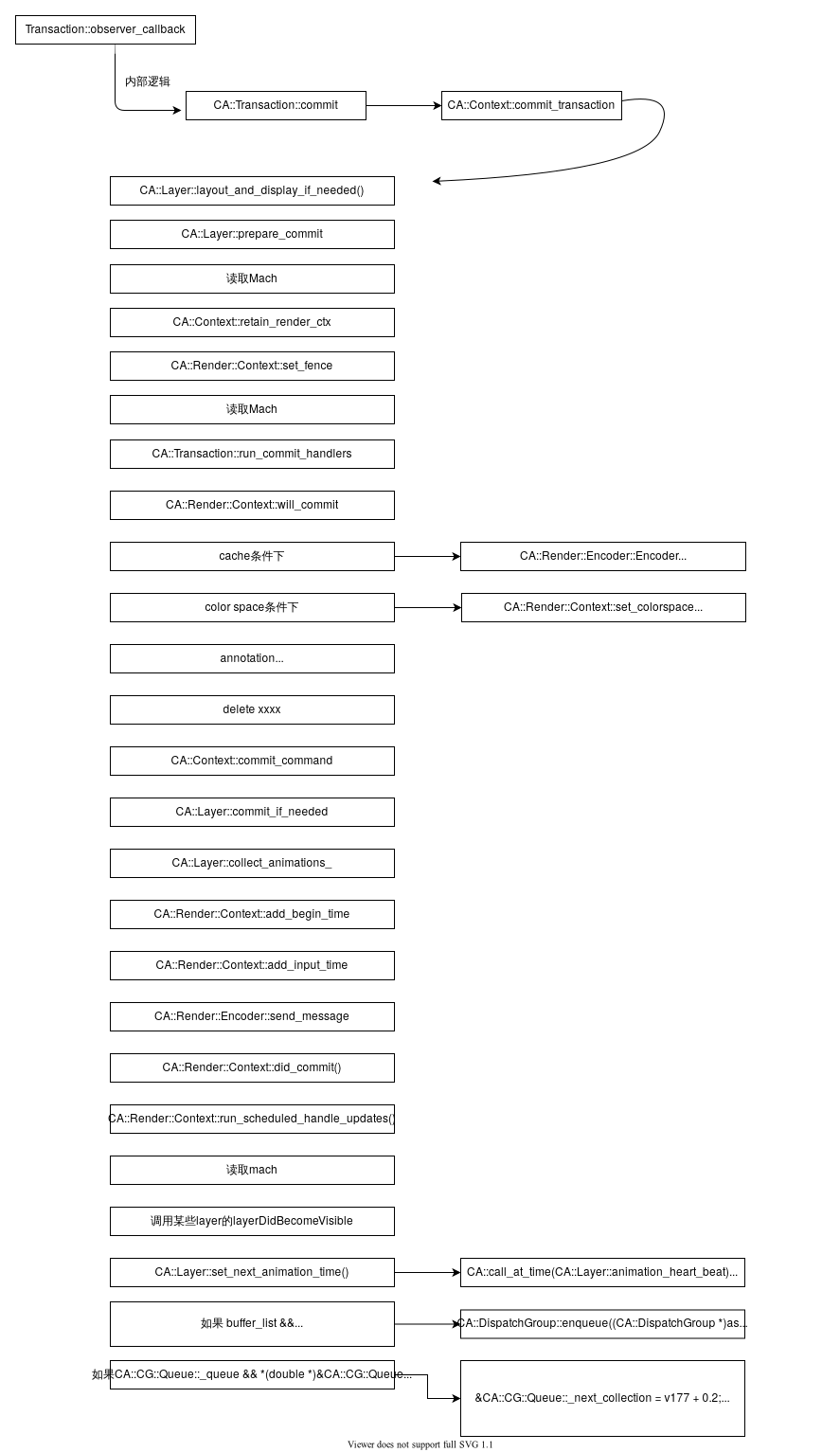
-
对 layer tree 调用 layoutIfNeeded
-
在这个过程中,实现从 CoreAnimation 到 UIKit 的上升,即最终调用到我们熟悉的
layoutSubviews等方法 -
layoutIfNeeded理论上只对setNeedsLayout过的 UIView(的 Layer)进行 layout 操作,frame、layout constraint等行为,均会setNeedsLayout,手动设置也会生效。 -
因此我们得出结论,通常情况下,大量的 layout`工作会在一次 Runloop 结束的时候全部开始,如果 layout engine 出现很多 broken,或者本身计算量过大(跨层较多,冗余约束较多等原因),则很有可能超时,导致一轮 Runloop 超过 16.7ms,
-
通过mach与其他线程 (render server) 通信
-
commitIfNeeded -
处理 Animation
下面看 commit_If_Needed 中的具体逻辑:
-
调用
[CALayer _copyRenderLayer:layerFlags:commitFlags] -
基于这个layer的各种属性,创建CA::Render::Object *
-
有layer级别的cache
-
根据情况使用ioSurface,data等多种数据源来生成bitmap(image)
-
调用
CA::Render::encode_set_object(),把前面创建的render obj set进去 -
调用
[CALayer _didCommitLayer:]
综上,当 App 的 Runloop 不管是被什么事件唤醒以后,总能在进入内核态之前完成当前所有UI 的更新任务,并通过 mach_msg 完成 commit 到 render server 的工作。最常见由 iOS 开发者控制的唤醒 Runloop 的行为有:
-
基于GCD的
-
在主线程上 dispatch_after() 或 dispatch_async
-
网络进程回调,dispatch_async到主线程
-
基于GS Event的
-
用户操作屏幕
-
用户操作物理按键
至此我们已经解答了以下问题:
- 一个 VC 的
layoutSubviews是什么时候触发的 - 为什么我在一个 UIButton 的点击事件里做了一个动画可以顺利的展示出来?动画是怎么生成的?
有任何你想了解的问题,欢迎在文章下方评论。
图形学时间
计算机动画扩展:计算机动画发展的很快,不再局限于某些物体的位置变换和伸缩变换,出现了很多算法实现各种效果,总结来看,计算机动画分为以下几种:
-
2D动画:
-
图像变形(Image Morphing)
-
形状混合(Shape blending)
-
3D动画:
-
关键帧动画
-
变形物体动画(自由体变形技术,FFD)
那么 CoreAnimation 在动画方面关注的显然是 2D 动画,我们也来讲解一下关于图像变形和形状混合。图像变形图像变形有两种基本的方法:
-
基于单张图像进行形变
-
如:宽高拉伸
-
基于多张图像进行插值
-
此方法可以引入用户交互,指定某些特征进行动画,更加可控
注意噢,这里的特征可不是 iOS 动画中的 property ,是指对某个图像人为框定几个特征点,进行拉伸形变。
形状混合
二维图形动画,都可以简化为为多边形处理。二维的形状混合,即在两个关键帧的多边形之间插入新的多边形。插入新的多边形,需要解决的问题就是前后两个关键帧之间,顶点的对应关系和顶点之间插值路径的问题。这两个问题在 siggraph 1992 和 1993 的论文上得到了解。
参考资料
[1]深入理解 RunLoop: https://blog.ibireme.com/2015/05/18/Runloop/
[2]Apple CFRunloop 源码: https://opensource.apple.com/source/CF/CF-635/CFRunLoop.c.auto.html
[3]界面渲染的整体流程: http://blog.handy.wang/blog/2015/10/03/uiviewyu-calayerxie-zuo-xuan-ran-jie-mian-de-guo-cheng/
